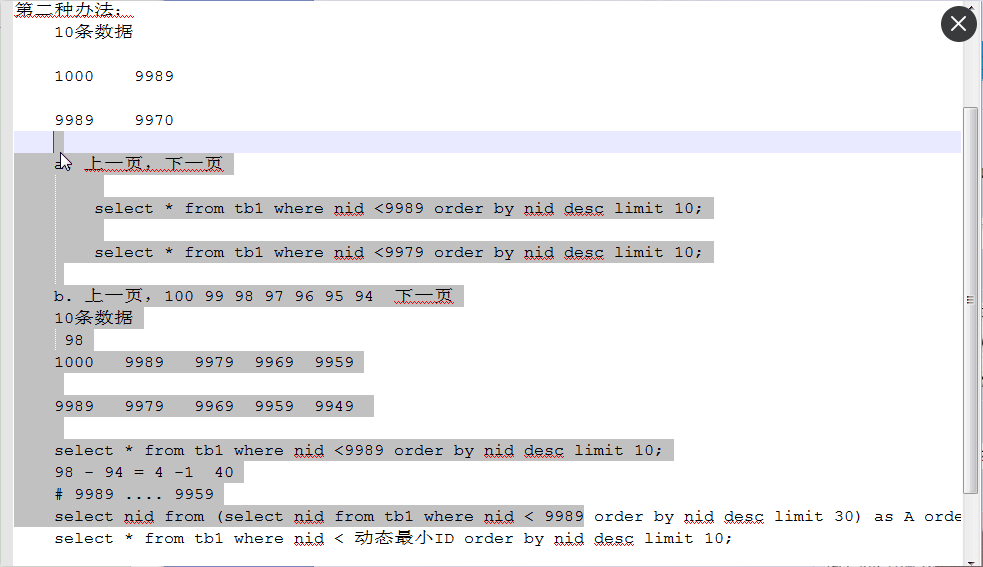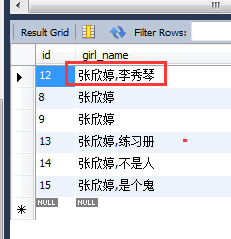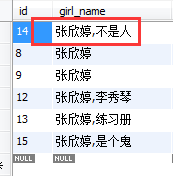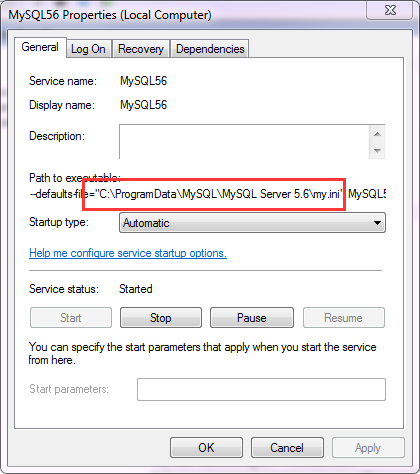什么是索引
索引用来快速地寻找那些具有特定值的记录,所有MySQL索引都以B-树的形式保存。如果没有索引,执行查询时MySQL必须从第一个记录开始扫描整个表的所有记录,直至找到符合要求的记录。表里面的记录数量越多,这个操作的代价就越高。如果作为搜索条件的列上已经创建了索引,MySQL无需扫描任何记录即可迅速得到目标记录所在的位置。如果表有1000个记录,通过索引查找记录至少要比顺序扫描记录快100倍。
假设我们创建了一个名为people的表:
create table people (peopleid SMALLINT NOT NULL,name CHAR(50) NOT NULL);
然后,我们完全随机把1000个不同name值插入到people表。
如果我们创建了name列的索引,MySQL将在索引中排序name列:
对于索引中的每一项,MySQL在内部为它保存一个数据文件中实际记录所在位置的“指针”。因此,如果我们要查找name等于“Mike”记录的peopleid(SQL命令为“SELECT peopleid FROM people WHERE name=’Mike’;”),MySQL能够在name的索引中查找“Mike”值,然后直接转到数据文件中相应的行,准确地返回该行的peopleid(999)。在这个过程中,MySQL只需处理一个行就可以返回结果。如果没有“name”列的索引,MySQL要扫描数据文件中的所有记录,即1000个记录!显然,需要MySQL处理的记录数量越少,则它完成任务的速度就越快。
普通索引:仅加速查询
唯一索引:加速查询+列值唯一(可以有null)
主键索引:加速查询+列值唯一表中只有一个(不可以有null)
组合索引:多列值组成一个索引,专门用于组合搜索,其效率大于索引合并
全文索引:对文本的内容进行分词,进行搜索。
索引合并:使用多个单列索引组合搜索
覆盖索引:select的数据列只用从索引中就能够取得,不必读取数据行,换句话说查询列要被所建的索引覆盖。
如何创建索引
创建表的时候创建索引1
2
3
4
5create table tbl name(
字段名陈 字段类型 [完整性约束条件],
,,,,
[UNIQUE|FULLTEXT|SPATIAL] INDEX|KEY [索引名称] (字段名称[长度])[ASC|DESC]
);
在已经存在的表上创建索引:1
21、create [unique|fulltext|spatial] index 索引名称 on 表名{字段名称[(长度)] [ASC|DESC]}
2、alter table ta1_name add [unique|fulltext|spatial] index 索引名称(字段名陈[(长度)] [ASC|DESC])
删除索引?1
drop index 索引名称 on tb1_name;
普通索引
普通索引仅有一个功能:加速查询
创建表+索引1
2
3
4
5
6
7create table in1(
nid int not null auto_increment primary key,
name varchar(32) not null,
email varchar(64) not null,
extra text,
index ix_name (name)
)
创建索引1
create index index_name on table_name(column_name)
删除索引1
drop index_name on table_name;
查看索引1
show index from table_name;
注意:对于创建索引时如果是BLOB和TEXT类型,必须指定length。1
create index ix_extra on in1(extra(32));
唯一性索引
唯一索引有两个功能:加速查询和唯一约束(可含null)
创建表+唯一索引1
2
3
4
5
6
7create table in1(
nid int not null auto_increment primary key,
name varchar(32) not null,
email varchar(64) not null,
extra text,
unique ix_name (name)
)
创建唯一索引1
create unique index 索引名 on 表名(列名)
删除索引1
drop unique index 索引名 on 表名
主键索引
主键有两个功能:加速查询和唯一约束(不可含null)
创建表+创建主键1
2
3
4
5
6
7
8
9
10
11
12
13
14
15
16create table in1(
nid int not null auto_increment primary key,
name varchar(32) not null,
email varchar(64) not null,
extra text,
index ix_name(name)
)
or
create table in1(
nid int not null auto_increment,
name varchar(32) not null,
email varchar(64) not null,
extra text,
primary key(nid),
index ix_name(name)
)
创建主键1
alter table 表名 add primary key(列名);
删除主键1
2alter table 表名 drop primary key;
alter table 表名 modify 列名 int,drop primary key;
组合索引
组合索引是将n个列组合成一个索引
其应用场景为:频繁的同时使用n列来进行查询,如:where n1 = ‘alex’ and n2 = 666。
创建表1
2
3
4
5
6create table in3(
nid int not null auto_increment primary key,
name varchar(32) not null,
email varchar(64) not null,
extra text
)
创建组合索引1
create index ix_name_email on in3(name,email);
如上创建组合索引之后,查询:
name and email –使用索引
name –使用索引
email –不使用索引
注意:对于同时搜索n个条件时,组合索引的性能好于多个单列索引合并。
相关命令1
2
3
4
5
6
7
8
9
10- 查看表结构
desc 表名
- 查看生成表的sql
show create table 表名
- 查看索引
show index from 表名
- 查看执行时间
set profiling = 1;
sql ...
show profiles;
使用索引和不使用索引1
2
3
4
5
6
7
8
9
10
11
12
13
14
15
16
17
18由于索引时专门用于加速搜索而生,所以加上索引之后,查询效率会快到飞起来。
# 有索引
mysql > select * from tb1 where name = 'wupeiqi-888';
+-----+-------------+---------------------+----------------------------------+---------------------+
| nid | name | email | radom | ctime |
+-----+-------------+---------------------+----------------------------------+---------------------+
| 889 | wupeiqi-888 | wupeiqi888@live.com | 5312269e76a16a90b8a8301d5314204b | 2016-08-03 09:33:35 |
+-----+-------------+---------------------+----------------------------------+---------------------+
1 row in set (0.00 sec)
# 无索引
mysql> select * from tb1 where email = 'wupeiqi888@live.com';
+-----+-------------+---------------------+----------------------------------+---------------------+
| nid | name | email | radom | ctime |
+-----+-------------+---------------------+----------------------------------+---------------------+
| 889 | wupeiqi-888 | wupeiqi888@live.com | 5312269e76a16a90b8a8301d5314204b | 2016-08-03 09:33:35 |
+-----+-------------+---------------------+----------------------------------+---------------------+
1 row in set (1.23 sec)
正确使用索引
数据库表中添加索引后确实会让查询速度起飞,但前提必须是正确的使用索引来查询,如果以错误的方式使用,则即使建立索引也会不奏效。
即使建立索引,索引也不会生效:1
2
3
4
5
6
7
8
9
10
11
12
13
14
15
16
17
18
19
20
21
22
23
24
25
26
27
28
29
30
31
32- like '%xx'
select * from tb1 where name like '%cn';
- 使用函数
select * from tb1 where reverse(name) = 'wupeiqi';
- or
select * from tb1 where nid = 1 or email = 'seven@live.com';
特别的:当or条件中有未建立索引的列才失效,以下会走索引
select * from tb1 where nid = 1 or name = 'seven';
select * from tb1 where nid = 1 or email = 'seven@live.com' and name = 'alex'
- 类型不一致
如果列是字符串类型,传入条件是必须用引号引起来,不然...
select * from tb1 where name = 999;
- !=
select * from tb1 where name != 'alex'
特别的:如果是主键,则还是会走索引
select * from tb1 where nid != 123
- >
select * from tb1 where name > 'alex'
特别的:如果是主键或索引是整数类型,则还是会走索引
select * from tb1 where nid > 123
select * from tb1 where num > 123
- order by
select email from tb1 order by name desc;
当根据索引排序时候,选择的映射如果不是索引,则不走索引
特别的:如果对主键排序,则还是走索引:
select * from tb1 order by nid desc;
- 组合索引最左前缀
如果组合索引为:(name,email)
name and email -- 使用索引
name -- 使用索引
email -- 不使用索引
其他注意事项1
2
3
4
5
6
7
8
9- 避免使用select *
- count(1)或count(列) 代替 count(*)
- 创建表时尽量时 char 代替 varchar
- 表的字段顺序固定长度的字段优先
- 组合索引代替多个单列索引(经常使用多个条件查询时)
- 尽量使用短索引
- 使用连接(JOIN)来代替子查询(Sub-Queries)
- 连表时注意条件类型需一致
- 索引散列值(重复少)不适合建索引,例:性别不适合
limit 分页
无论是否有索引,limit分页是一个值得关注的问题

1
2
3
4
5
6
7
8
9
10
11
12
13
14
15
16
17
18
19
20
21
22
23
24
25
26
27
28
29
30
31
32
33
34
35
36
37
38
39
40
41
42
43
44
45
46
47
48
49
50
51每页显示10条:
当前 118 120, 125
倒序:
大 小
980 970 7 6 6 5 54 43 32
21 19 98
下一页:
select
*
from
tb1
where
nid < (select nid from (select nid from tb1 where nid < 当前页最小值 order by nid desc limit 每页数据 *【页码-当前页】) A order by A.nid asc limit 1)
order by
nid desc
limit 10;
select
*
from
tb1
where
nid < (select nid from (select nid from tb1 where nid < 970 order by nid desc limit 40) A order by A.nid asc limit 1)
order by
nid desc
limit 10;
上一页:
select
*
from
tb1
where
nid < (select nid from (select nid from tb1 where nid > 当前页最大值 order by nid asc limit 每页数据 *【当前页-页码】) A order by A.nid asc limit 1)
order by
nid desc
limit 10;
select
*
from
tb1
where
nid < (select nid from (select nid from tb1 where nid > 980 order by nid asc limit 20) A order by A.nid desc limit 1)
order by
nid desc
limit 10;
执行计划
explain + 查询SQL – 用于显示SQL执行信息参数,根据参考信息可以进行SQL优化1
2
3
4
5
6
7mysql> explain select * from tb2;
+----+-------------+-------+------+---------------+------+---------+------+------+-------+
| id | select_type | table | type | possible_keys | key | key_len | ref | rows | Extra |
+----+-------------+-------+------+---------------+------+---------+------+------+-------+
| 1 | SIMPLE | tb2 | ALL | NULL | NULL | NULL | NULL | 2 | NULL |
+----+-------------+-------+------+---------------+------+---------+------+------+-------+
1 row in set (0.00 sec)
执行计划1
2
3
4
5
6
7
8
9
10
11
12
13
14
15
16
17
18
19
20
21
22
23
24
25
26
27
28
29
30
31
32
33
34
35
36
37
38
39
40
41
42
43
44
45
46
47
48
49
50
51
52
53
54
55
56
57
58
59
60
61
62
63
64
65
66
67
68
69
70
71
72
73
74
75
76
77
78
79
80
81
82
83id
查询顺序标识
如:mysql> explain select * from (select nid,name from tb1 where nid < 10) as B;
+----+-------------+------------+-------+---------------+---------+---------+------+------+-------------+
| id | select_type | table | type | possible_keys | key | key_len | ref | rows | Extra |
+----+-------------+------------+-------+---------------+---------+---------+------+------+-------------+
| 1 | PRIMARY | <derived2> | ALL | NULL | NULL | NULL | NULL | 9 | NULL |
| 2 | DERIVED | tb1 | range | PRIMARY | PRIMARY | 8 | NULL | 9 | Using where |
+----+-------------+------------+-------+---------------+---------+---------+------+------+-------------+
特别的:如果使用union连接气值可能为null
select_type
查询类型
SIMPLE 简单查询
PRIMARY 最外层查询
SUBQUERY 映射为子查询
DERIVED 子查询
UNION 联合
UNION RESULT 使用联合的结果
...
table
正在访问的表名
type
查询时的访问方式,性能:all < index < range < index_merge < ref_or_null < ref < eq_ref < system/const
ALL 全表扫描,对于数据表从头到尾找一遍
select * from tb1;
特别的:如果有limit限制,则找到之后就不在继续向下扫描
select * from tb1 where email = 'seven@live.com'
select * from tb1 where email = 'seven@live.com' limit 1;
虽然上述两个语句都会进行全表扫描,第二句使用了limit,则找到一个后就不再继续扫描。
INDEX 全索引扫描,对索引从头到尾找一遍
select nid from tb1;
RANGE 对索引列进行范围查找
select * from tb1 where name < 'alex';
PS:
between and
in
> >= < <= 操作
注意:!= 和 > 符号
INDEX_MERGE 合并索引,使用多个单列索引搜索
select * from tb1 where name = 'alex' or nid in (11,22,33);
REF 根据索引查找一个或多个值
select * from tb1 where name = 'seven';
EQ_REF 连接时使用primary key 或 unique类型
select tb2.nid,tb1.name from tb2 left join tb1 on tb2.nid = tb1.nid;
CONST 常量
表最多有一个匹配行,因为仅有一行,在这行的列值可被优化器剩余部分认为是常数,const表很快,因为它们只读取一次。
select nid from tb1 where nid = 2 ;
SYSTEM 系统
表仅有一行(=系统表)。这是const联接类型的一个特例。
select * from (select nid from tb1 where nid = 1) as A;
possible_keys
可能使用的索引
key
真实使用的
key_len
MySQL中使用索引字节长度
rows
mysql估计为了找到所需的行而要读取的行数 ------ 只是预估值
extra
该列包含MySQL解决查询的详细信息
“Using index”
此值表示mysql将使用覆盖索引,以避免访问表。不要把覆盖索引和index访问类型弄混了。
“Using where”
这意味着mysql服务器将在存储引擎检索行后再进行过滤,许多where条件里涉及索引中的列,当(并且如果)它读取索引时,就能被存储引擎检验,因此不是所有带where子句的查询都会显示“Using where”。有时“Using where”的出现就是一个暗示:查询可受益于不同的索引。
“Using temporary”
这意味着mysql在对查询结果排序时会使用一个临时表。
“Using filesort”
这意味着mysql会对结果使用一个外部索引排序,而不是按索引次序从表里读取行。mysql有两种文件排序算法,这两种排序方式都可以在内存或者磁盘上完成,explain不会告诉你mysql将使用哪一种文件排序,也不会告诉你排序会在内存里还是磁盘上完成。
“Range checked for each record(index map: N)”
这个意味着没有好用的索引,新的索引将在联接的每一行上重新估算,N是显示在possible_keys列中索引的位图,并且是冗余的。
慢日志查询
a、配置MySQL自动记录慢日志1
2
3
4slow_query_log = OFF 是否开启慢日志记录
long_query_time = 2 时间限制,超过此时间,则记录
slow_query_log_file = /usr/slow.log 日志文件
log_queries_not_using_indexes = OFF 为使用索引的搜索是否记录
注:查看当前配置信息:
show variables like ‘%query%’
修改当前配置:
set global 变量名 = 值
b、查看mysql慢日志
mysqldumpslow -s at -a /usr/local/var/mysql/MacBook-Pro-3-slow.log
参数详解1
2
3
4
5
6
7
8
9
10
11
12
13
14
15
16
17
18
19
20
21
22
23
24--verbose 版本
--debug 调试
--help 帮助
-v 版本
-d 调试模式
-s ORDER 排序方式
what to sort by (al, at, ar, c, l, r, t), 'at' is default
al: average lock time
ar: average rows sent
at: average query time
c: count
l: lock time
r: rows sent
t: query time
-r 反转顺序,默认文件倒序拍。reverse the sort order (largest last instead of first)
-t NUM 显示前N条just show the top n queries
-a 不要将SQL中数字转换成N,字符串转换成S。don't abstract all numbers to N and strings to 'S'
-n NUM abstract numbers with at least n digits within names
-g PATTERN 正则匹配;grep: only consider stmts that include this string
-h HOSTNAME mysql机器名或者IP;hostname of db server for *-slow.log filename (can be wildcard),
default is '*', i.e. match all
-i NAME name of server instance (if using mysql.server startup script)
-l 总时间中不减去锁定时间;don't subtract lock time from total time
全文索引
创建全文索引(FullText index)
旧版的MySQL的全文索引只能用在MyISAM表格的char、varchar和text的字段上。
不过新版的MySQL5.6.24上InnoDB引擎也加入了全文索引,所以具体信息要随时关注官网,
创建表的同时创建全文索引1
2
3
4
5
6create table article(
id int auto_increment not null primary key,
title varchar(200),
body text,
fulltext(title,body)
)type=myisam;
通过alter table的方式来添加
alter table ‘student’ add fulltext index ft_stu_name(‘name’)#ft_stu_name是索引名,可以随便起
或者:alter table ‘student’ add fulltext ft_stu_name(‘name’)
直接通过create index的方式
create fulltext index ft_email_name on ‘student’(‘name’)
也可以在创建索引的时候指定索引的长度:
create fulltext index ft_email_name on ‘student’(‘name’(20))
删除全文索引
直接使用drop index(注意:没有 drop fulltext index 这种用法)
drop index full_idx_name on tommy.girl;
使用alter table的方式
alter table tommy.girl drop index ft_email_abck;
使用全文索引
跟普通索引稍有不同
使用全文索引的格式: MATCH (columnName) AGAINST (‘string’)
eg:
select from ‘student’ where match(‘name’) against(‘聪’);
当查询多列数据时:
建议在此多列数据上创建一个联合的全文索引,否则使用不了索引的。
select from ‘student’ where match(‘name’,’address’) AGAINST(‘聪 广东’);
使用全文索引需要注意的是:(基本单位是词)
分词,全文索引以词为基础,MySQL默认的分词是所有非字母和数字的特殊符号都是分词符
MySQL中与全文索引相关的几个变量:
使用命令:mysql> SHOW VARIABLES LIKE ‘ft%’; #ft就是FullText的简写
ft_boolean_syntax + -><()~:””&| #改变IN BOOLEAN MODE的查询字符,不用重新启动MySQL也不用重建索引
ft_min_word_len 4 #最短的索引字符串,默认值为4,(通常改为1)修改后必须重建索引文件
重新建立索引命令:repair table tablename quick
ft_max_word_len 84 #最长的索引字符串,默认值为84,修改后必须重建索引文件
ft_query_expansion_limit 20 #查询括展时取最相关的几个值用作二次查询
ft_stopword_file (built-in) #全文索引的过滤词文件,具体可以参考:MySQL全文检索中不进行全文索引默认过滤词
特别注意:50%的门坎限制(当查询结果很多,几乎所有记录都有,或者极少的数据,都有可能会返回非所期望的结果)
–>可用IN BOOLEAN MODE即可以避开50%的限制。
此时使用全文索引的格式就变成了: SELECT FROM student WHERE MATCH(name) AGAINST(‘聪’ IN BOOLEAN MODE)
ft_boolean_syntax (+ -><()~:””&|)使用的例子:
4.1 + : 用在词的前面,表示一定要包含该词,并且必须在开始位置。
eg: +Apple 匹配:Apple123, “tommy, Apple”
4.2 - : 不包含该词,所以不能只用「-yoursql」这样是查不到任何row的,必须搭配其他语法使用。
eg: MATCH (girl_name) AGAINST (‘-林志玲 +张筱雨’)匹配到: 所有不包含林志玲,但包含张筱雨的记录
4.3. 空(也就是默认情况),表示可选的,包含该词的顺序较高。
例子:apple banana 找至少包含上面词中的一个的记录行
+apple +juice 两个词均在被包含
+apple macintosh 包含词 “apple”,但是如果同时包含 “macintosh”,它的排列将更高一些
+apple -macintosh 包含 “apple” 但不包含 “macintosh”
4.4. > :提高该字的相关性,查询的结果会排在比较靠前的位置。
4.5.< :降低相关性,查询的结果会排在比较靠后的位置。
例子:4.5.1.先不使用 ><
select from tommy.girl where match(girl_name) against(‘张欣婷’ in boolean mode); 可以看到完全匹配的排的比较靠前
可以看到完全匹配的排的比较靠前
4.5.2. 单独使用 >
select from tommy.girl where match(girl_name) against(‘张欣婷 >李秀琴’ in boolean mode); 使用了>的李秀琴马上就排到最前面了
使用了>的李秀琴马上就排到最前面了
4.5.3. 单独使用 <
select from tommy.girl where match(girl_name) against(‘张欣婷 <不是人’ in boolean mode);
 看到没,不是人也排到最前面了,这里使用的可是 < 哦,说好的降低相关性呢,往下看吧。
看到没,不是人也排到最前面了,这里使用的可是 < 哦,说好的降低相关性呢,往下看吧。
4.5.4.同时使用><
select * from tommy.girl where match(girl_name) against(‘张欣婷 >李秀琴 <练习册 <不是人>是个鬼’ in boolean mode);
 到这里终于有答案了,只要使用了 ><的都会往前排,而且>的总是排在<的前面
到这里终于有答案了,只要使用了 ><的都会往前排,而且>的总是排在<的前面
小结一下:1. 只要使用 ><的总比没用的 靠前;
- 使用 >的一定比 <的排的靠前 (这就符合相关性提高和降低);
- 使用同一类的,使用的越早,排的越前。
4.6. ( ):可以通过括号来使用字条件。
eg: +aaa +(>bbb < ccc) // 找到有aaa和bbb和ccc,aaa和bbb,或者aaa和ccc(因为bbb,ccc前面没有+,所以表示可有可无),然后 aaa&bbb > aaa&bbb&ccc > aaa&ccc
4.7. ~ :将其相关性由正转负,表示拥有该字会降低相关性,但不像「-」将之排除,只是排在较后面。
eg: +apple ~macintosh 先匹配apple,但如果同时包含macintosh,就排名会靠后。
4.8. :通配符,这个只能接在字符串后面。
MATCH (girl_name) AGAINST (‘+ABC‘) #错误,不能放前面
MATCH (girl_name) AGAINST (‘+张筱雨‘) #正确
4.9. “ “ :整体匹配,用双引号将一段句子包起来表示要完全相符,不可拆字。
eg: “tommy huang” 可以匹配 tommy huang xxxxx 但是不能匹配 tommy is huang。
5.补充:Windows下无法修改 ft_min_word_len的情况,
